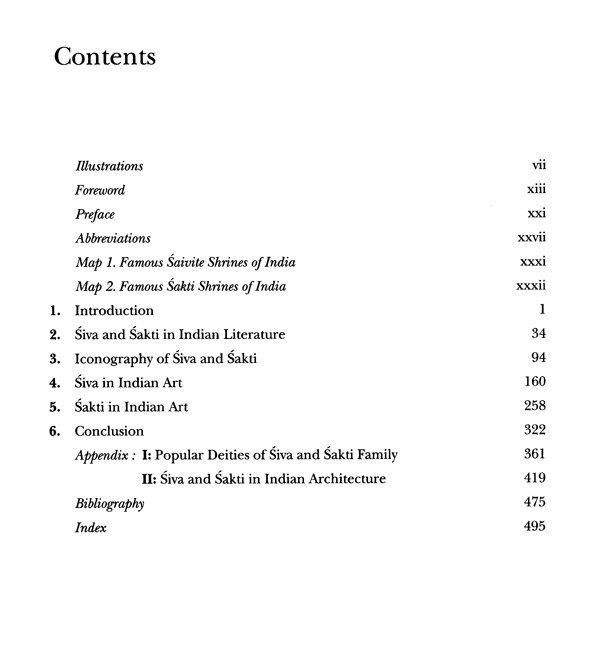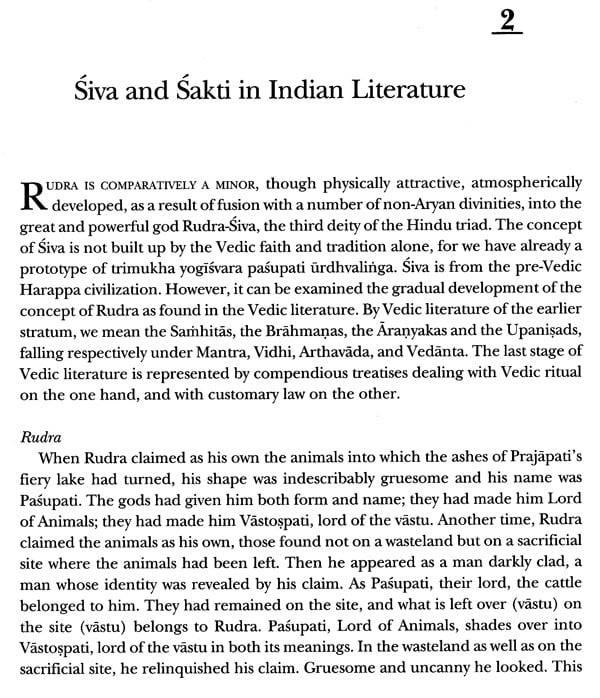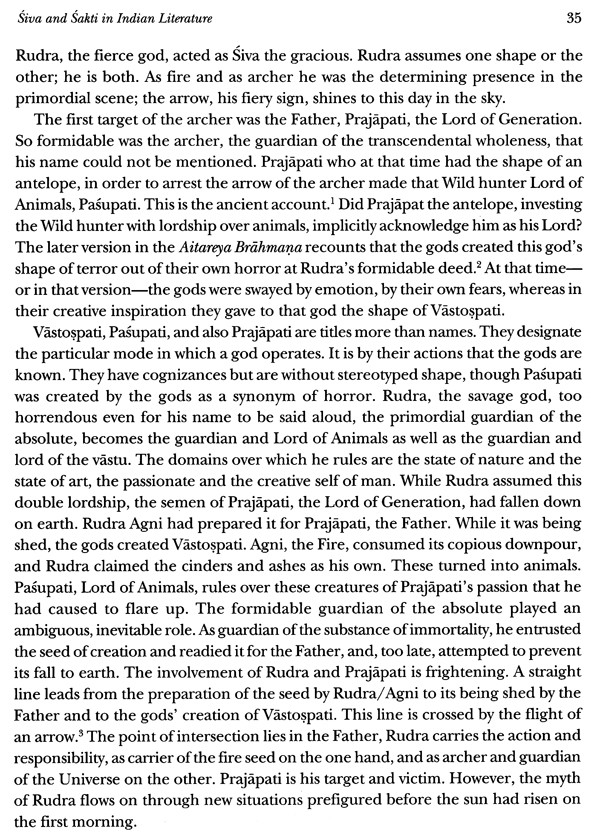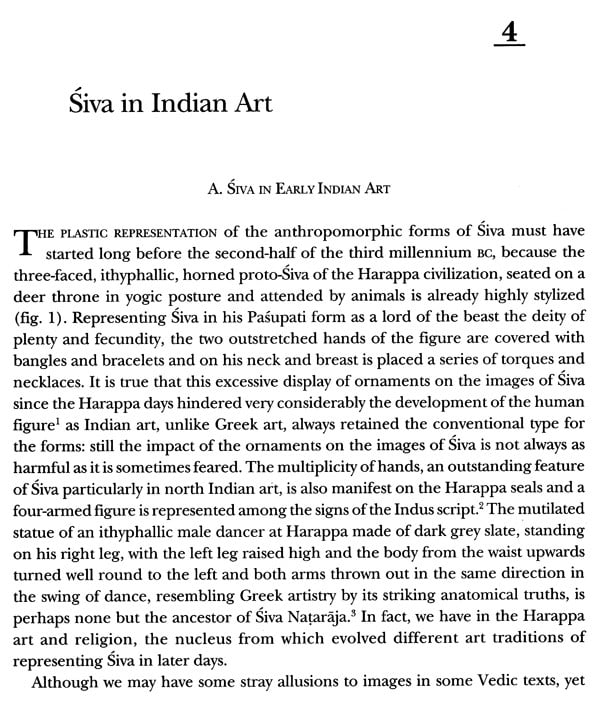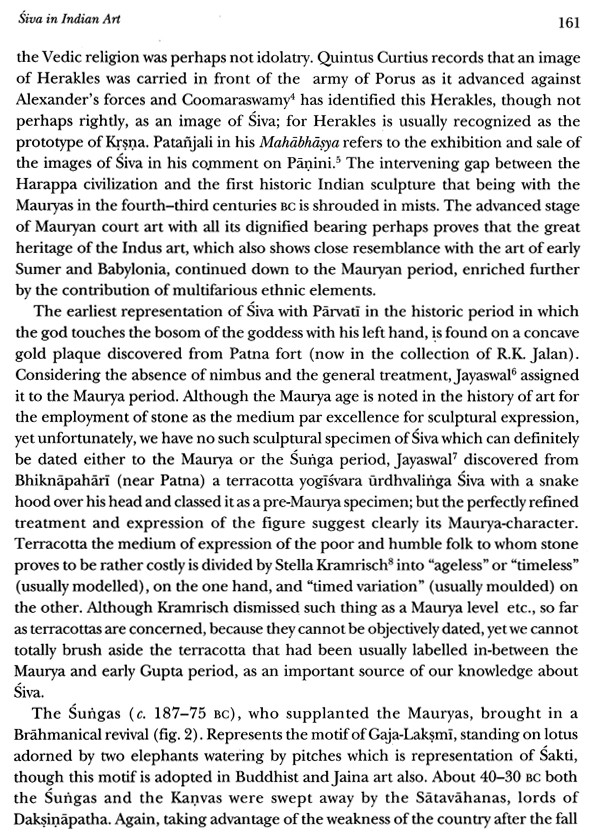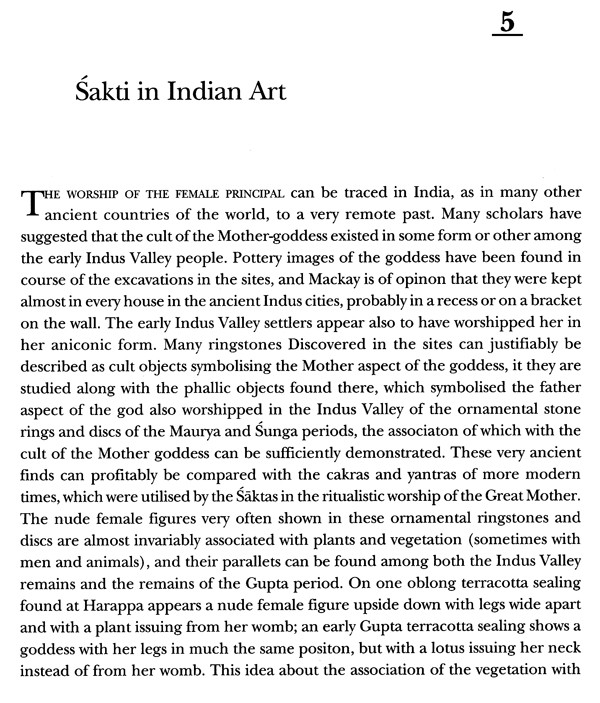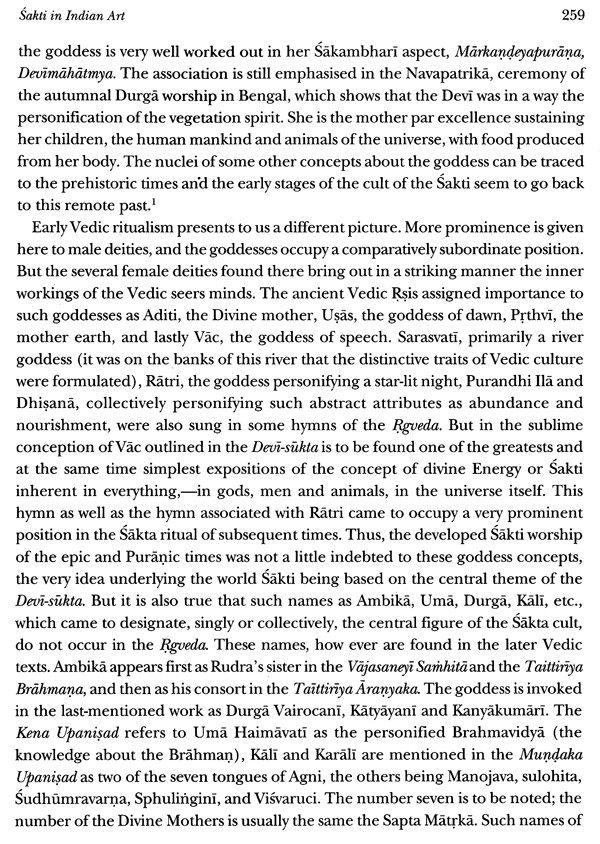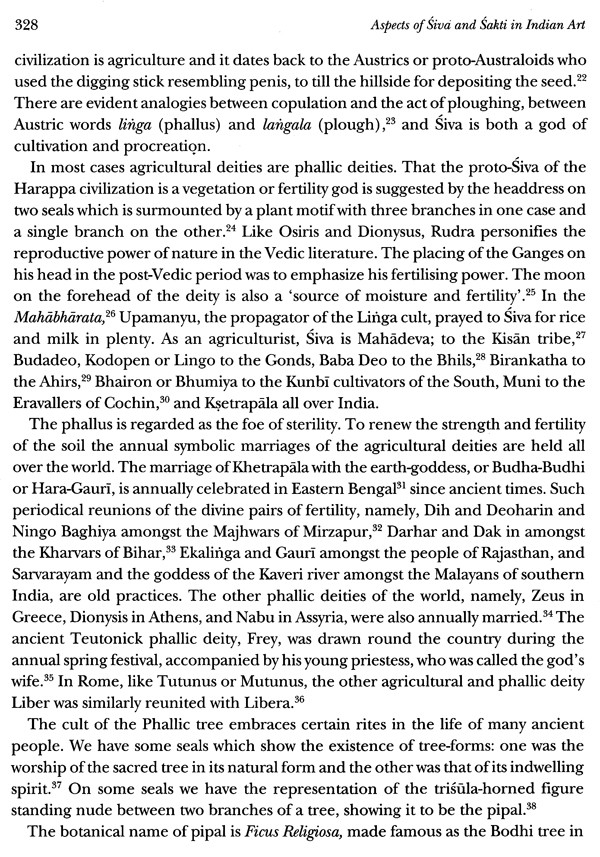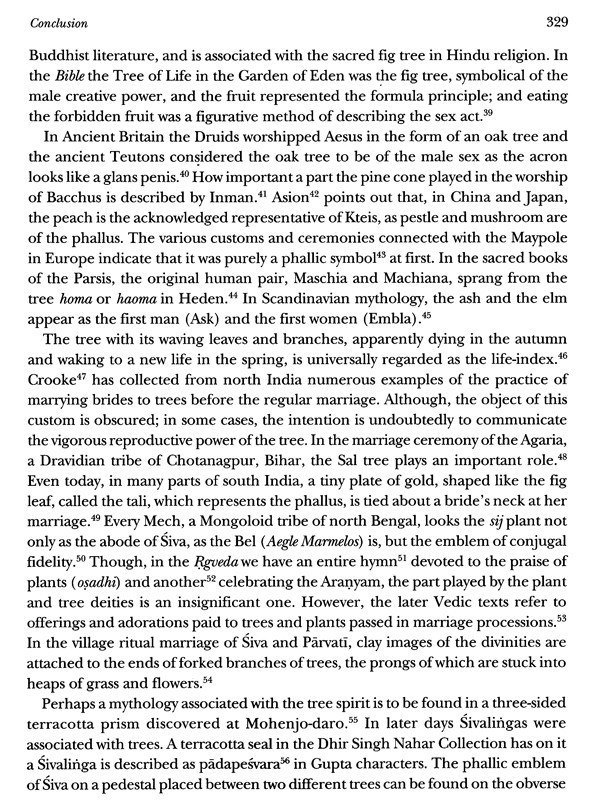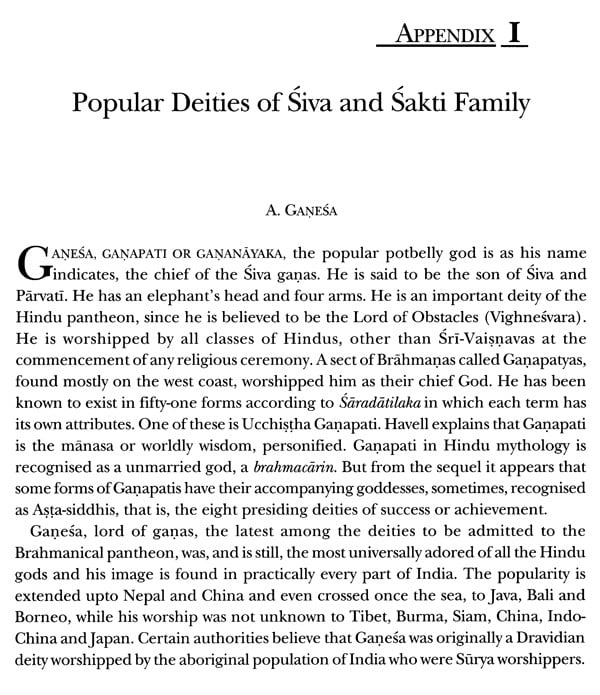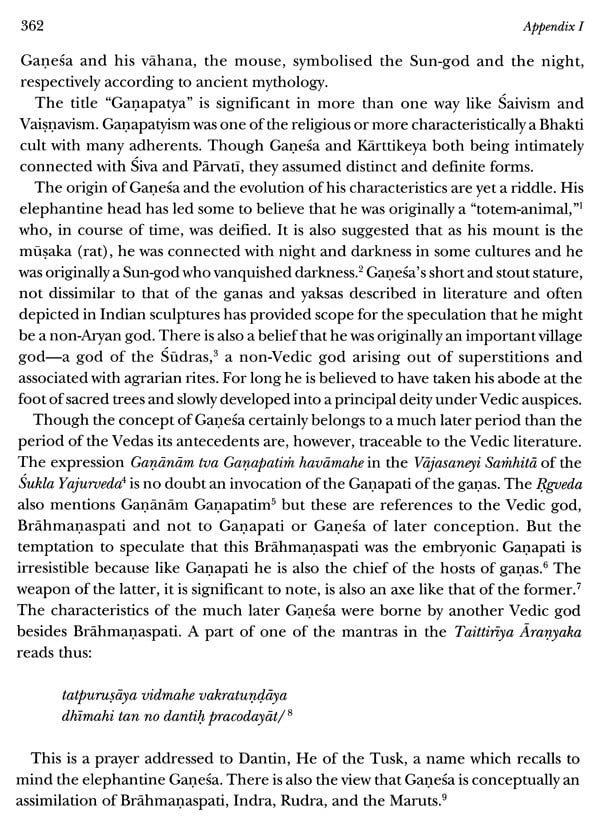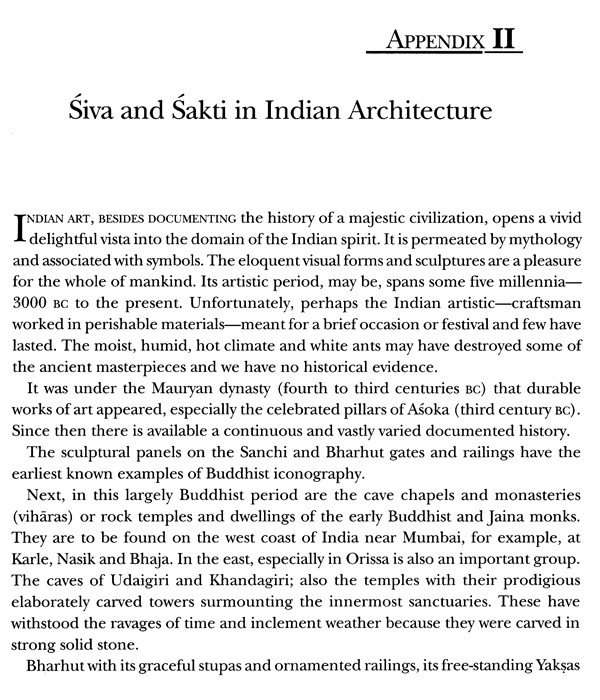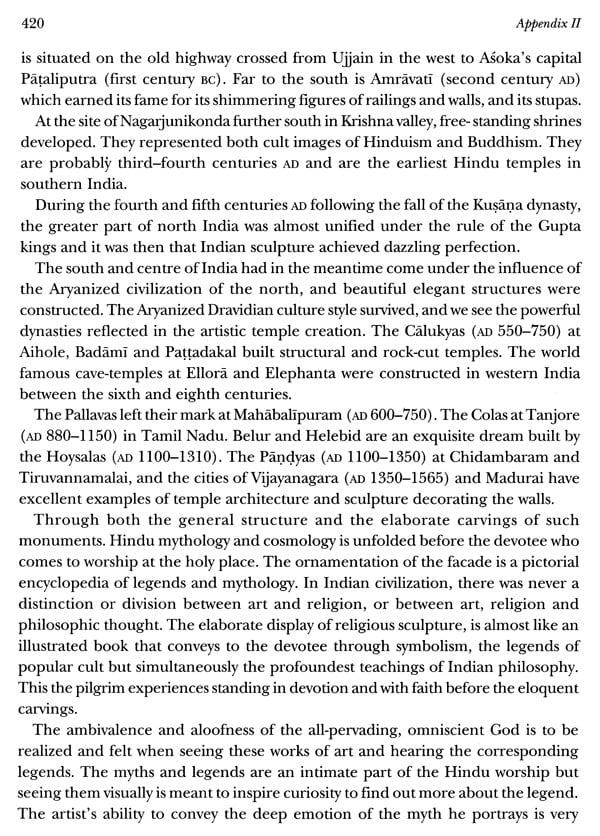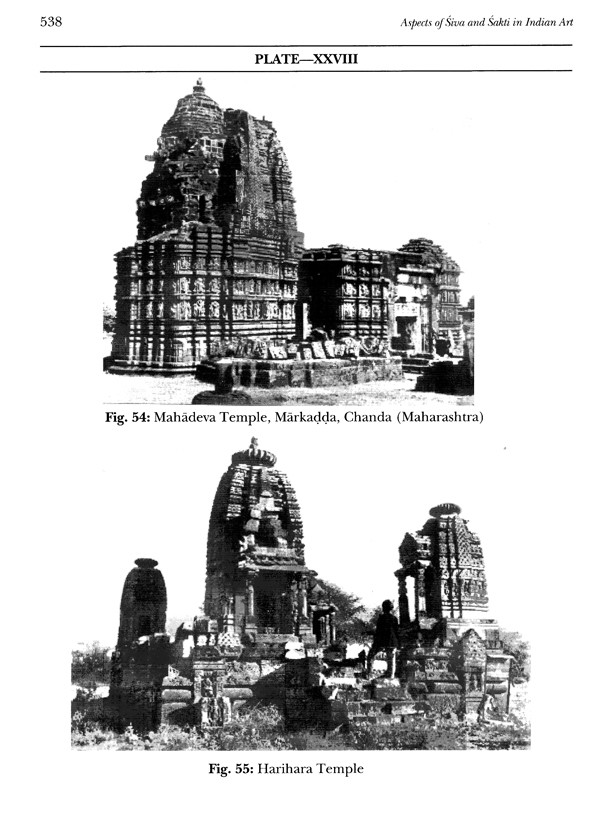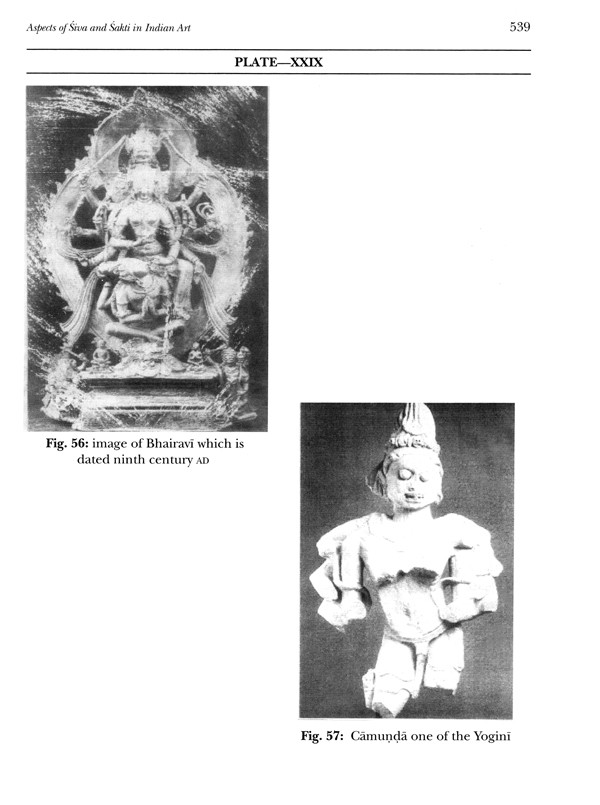
Aspects of Siva and Sakti in Indian Art- Earliest Times to The Cola Period
Book Specification
| Item Code: | UAC254 |
| Author: | Kamal Shankar Srivastava |
| Publisher: | MUNSHIRAM MANOHARLAL PUBLISHERS PVT LTD |
| Language: | English |
| Edition: | 2021 |
| ISBN: | 9788121512800 |
| Pages: | 562 (Throughout B/W Illustrations) |
| Cover: | HARDCOVER |
| Other Details | 11.00X9.00 inch |
| Weight | 1.67 kg |
Book Description
The monograph entitled Aspects of Siva and Sakti in Indian Art authored by Dr Kamal Shankar Srivastava is based on the literary and archaeological data pertaining to various forms-theriomorphic, anthropomorphic, and phallic of Siva and Sakti, which are depicted in Indian art from the earliest times to the Cola period. The concept of Siva and Sakti, the fundamental of creation in Indian philosophy, has been discussed elaborately in the ancient texts, while the temples, icons and paintings from the material expression of this concept with a holistic understanding almost all the significant aspects of Siva and Sakti narrations with their philosophical explanations have been incorporated in the proposed work. The long time span selected for this study helps demarcating the formulation, development and elaboration of the concept, as well as the artistic amplitude of Siva and Sakti in the art and culture of India.
The subject matter of the present work has been divided into six chapters: Introduction; Siva and Sakti in Indian Literature; Iconography of Siva and Sakti; Siva in Indian Art; Sakti in Indian Art; and Conclusion, besides two Appendices on Popular Deities of Siva and Sakti Family (especially Ganesa, Karttikeya, Nandi, and related allies) and Siva and Sakti in Indian Architecture; apart for a detailed Bibliography and 106 figures and 2 maps provide reading references and visual data.
The present work reflects the abstract and views of to ascertain the place, importance, role as well as theme of depiction of Siva and Sakti through the ages and phases of art, philosophy, literarily and iconographically faith in Saivism is an outgrowth of religion. The phallic emblem of Siva as found in the ruins of Indus Valley Civilizations, is even toda. an object of worship among the followers of Saivism. It is a living faith all over India, Saivism in its characteristic prevalent form worship of Siva and Sakti in union, i.e., the symbolic form of a Lingam and Yoni.
This monograph is especially self-explanatory and fruitful for art-lovers and the scholars of religious history of art and iconography.
Dr Kamal S. Srivastava, IAS, born in Varanasi (UP), Indian eminent scholar, Indologist, Museologist, Journalist, Art-historian, and Academician turned Administrator, obtained Post-Graduate degrees (MAs) in seventeen different disciplines: Ancient Indian History, Culture and Archaeology; History; Museology; English literature; Mass-Communication; Public Administration; Sociology; Hindi literature; Sanskrit literature; Philosophy; and Religion; Political Science; Social work; Economics; Defence Studies; and Linguistics; apart from Master of Business Administration (MBA-HRM) and Master of Law (LLM). Awarded BHU Gold Medal in 1981, in 1985, awarded PhD degree in AIHC and Archaeology, and in 2003 awarded DLitt from BHU Varanasi Besides these, he was also awarded post-graduate diplomas in elevan different disciplines, i.e., Business Administration, Tourism Administration, Human Rights Law, Corporate Law and Management, Environmental Law, Alternative Dispute Resolution, Intellectual Property Rights Law, Labour Law, Sustainable Rural Development, Tribal Development Management, and Cyber Law.
Author of more than ninety-nine published and under-publication books concerning different fields of Indian History, Art, Religion and Culture, Iconography, Museology, Tourism, Journalism, Painting, Indology, Literature, Heritage and Law, etc., he is Life-Fellow of Numismatics Society of India; Museums Association of India, Bihar Puravid Parishad, Patna; Institute of Constitutional and Parliamentary Studies, New Delhi; and Indian Social Science Academy and is Executive Member of Museum Association of India (New Delhi). He has presented several papers and articles more than one hundred and twenty in the fields of art, Indology, Museology, Law and Education. Attended two weeks training programme on SAARC Countries in Bangladesh, Dhaka.
At present, he is an officer of Indian Administrative Service (IAS), as a Director, Primary Education, Department of School Education and Literacy, Government of Jharkhand (Ranchi).
As POPULAR BELIEFS IN INDIA are polytheistic and Vedas so speak of many gods. This is especially in designation of supreme as Siva, in a land where Trinity of Brahma, Visnu and Siva is spoken of suggesting that god, Siva, was only primus inter pares and that there were other gods besides him. To exclude this notion, while not actually denying the existence of a plurality of gods, Siva was called "Incomparable" and was repeatedly said to be so high above the other gods, that they could not ever recognise him. And anyway he is said to differ in nature from other gods. The rising and setting of the sun, shining of the moon and blowing of winds were phenomena of awe. Wonder and devotion to the pure and simple mind of prehistoric people as was the natural urge of creation and multiplication in all living beings. This led to the beginning of the worship of Purusa and Prakrti, Siva and Sakti or Linga and Yoni in the prehistoric time. Siva in his Pasupati form was the beast. The deity of "Plenty and Fecundity," worshipped by the Indus Valley people. The Harappa Pasupati gradually blended with the Vedic Rudra, the awesome god of thunder, "fierce and destructive like a terrible beast." He is a 'bull' exalted, the `strong among the strong,' rapid and swift' the unaging Asura, Igana of the whole world.
The Saktism as a major belief of Hinduism is the religion of the devotee of Sakti (Potency) stands at the centre of philosophical and theological speculation and ritual endeavour. Sakti is the active, motive principle (conceived of as female and represented in form of a goddess), that lies behind all growth and decay and in fact, all transformation in the world depends on its myriad apparitional forms, likewise also the psycho-physical setup of mankind provoking self-experience of mental and physical development. Even in man's search for illumination from cycle of living, the decisive break through, the ultimate goal of human striving according to his religion attainable only with the help of Sakti. In meditation, he attempts to both experience her presence and enlist her active and potent support for his own goals.
Jagadguru Sankaracarya in his Saundaryalahari declares that Siva can create only when united with Sakti otherwise he is unable even to move. The Agama texts extol the inextricable nature of the conjoint Purusa Prakrti aspect.
Indeed Siva and Sakti are inseparable like heat from fire, whiteness from milk, sweatness from sugar, luminosity from light, weight from material bodies. Sakti as the divine energy, combines with Siva, i.e., two modes of manifestation of the Eternal and Infinite cosmos as Purusa and Prakrti, matter and spirit, i.e., Siva and Sakti.
In the archaeological field, the presence of Siva in antiquities remains of Indus civilization the antiquities of which goes back to nearly three thousand years Before Christian Era. In the sites of Harappa and Mohenjo-daro, Siva is found represented in both his aniconic and anthropomorphic forms. Various lingas (Plallus) and yonis in Terracotta as well as in stone have been unearthed from these sites. Besides the seal, which represents the god in human form, with horns over his head surrounded by wild life and seated in Yogasana. These seals have been interpreted to mean his Mahayogisvara form. In archaeological field, Siva again appears in early Indian coinage in systematic form of a trident, a linga and a bull during third-second centuries BC. But in Kusana coins, he appears in anthropomorphic form. Occasionally accompanied by his consort (Sakti) and his mount Nandi. The coins issued by Kadphises IV, Kaniska and Huviska show the provenance of the image of Siva on a bull, the image of Siva and name of the deity Oesho on reverse sides of gold coins.
Sir John Marshall has recognised the worship of certain deities connected with Saivism, like the seated god amidst animals (Pasupati) in a position of Yoga. Some what like Kurmasana, ithyphallic, cross begged upon a low throne or dias flanked by antelopes. The side faces represent the triad, because of three heads, J.N. Banerjea has described that epic or Puranic Siva undoubtedly had his Vedic and pre-Vedic counterparts or prototypes, Rudra was the Vedic counterpart of Siva. According to Banerjea, the worship of the female principle can be found in India as in many other ancient countries of the world, to a very remote past, and the cult of Mother-goddess existed in some form or other among the early Indus Valley people.
M. Wheeler represents a Siva lingam, a conical terracotta object with a rounded top of Harappa archaeological site, as probably a phallus. He also assumes the characteristics prevalent form of a worship of Siva and Sakti in union is symbolic form of a lingam and yoni. The Cola bronze images of dancing Siva Nataraja is expressed the cosmic dancer of Siva on Nataraja by A.K. Coomaraswamy, the great poineer of Indian art. K.P. Jayaswal represents a conclave gold plaque discovered ftom Patna as early representation of Siva and Sakti in historic period. C. Sivaramamurti has described the Sivalinga from Bhita with five heads corresponding to Jatapurusa, Aghora, Sadyojata, Isana, Vamadeva and composing Sadasiva. T.A. Gopinath Rao, Kapila Vatsyayana and Douglas Barret have described the manysided personality of cosmic dancer Siva.
All these authorities have described the artistic, iconographic, characters of Siva and traces of Sakti including mother goddess. But in my own view regarding Siva and Sakti may be traced and interpreted the systematic and chronological artistic representation based on gradual iconographic order from aniconic form to anthropomorphic representation and carving of these sculptures, terracotta figurines, coins, paintings and bronzes on gradual development of artistic representation and techniques of depiction in differnt phases, i.e., since the earliest times to Cola period. Apart from the various provenance architecture related to the icons of Siva and Sakti in various forms from aniconic to anthropomorphic specimens including theriomorphic representation through the ages, i.e., upto Cola Period.
THE PRESENT MONOGRAPH is based on the literary and archaeological data pertaining to various forms-theriomorphic, anthropomorphic, and phallic of Siva and Sakti, which are depicted in Indian art from the earliest times to the Cola periods. The concepts of Siva and Sakti, the fundamental of creation in Indian philosophy have been discussed elaborately in the ancient texts, while the temples, images and paintings form the material expression of this concept with a holistic understanding. Almost all the significant aspects of Siva and Sakti narrations with their philosophical explanations have been incorporated in the proposed work. The long time span selected for this study helps demarcating the formulation, development and elaboration of the concept, as well as the artistic amplitude of Siva and Sakti in the art and culture of India.
The subject matter of the present work has been divided into six chapters-(1) Introduction, (2) Siva and Sakti in Indian Literature, (3) Iconography of Siva and Sakti, (4) Siva in Indian Art, (5) Sakti in Indian Art, and (6) Conclusion; besides, a detailed Bibliography and sufficient Illustrations, provide reading references and visual data.
The first chapter "Introduction" includes the Siva and Sakti since prehistoric period. Siva existed at the dawn of prehistory when society was dominated by a pantheon of female divinities. His cult fused with that of the great Mother-goddess, Sakti. Union was not difficult when people realized that two were complementary halves of the whole truth like man and woman, the linga and the yoni. The Rgveda the oldest religious text known to mankind, refers to Siva as Rudra, the wild god. Gifts, hymns and sacrifices were offered to appease him. He was so feared that one is advised in Aitareya Brahmana against even mentioning his name.
This chapter traces the Rudra as deity referred to Rgveda in the various phases of representation. As per the Siva and Sakti and their depiction in Indian Art, several scholars and authorities have thrown the light regarding the representation of Siva and Sakti in Indian Art and their artistic details.
M. Wheeler has reported a conical terrocotta object with a rounded top from Harappan site. He also assumes that phallus form of Siva and Sakti was prevalent during this time. R.D. Banerji has reported water reservoir found at Mohenjo-daro, as Caranamrtakunda which is a common feature of temple of Siva.
Worship of Phallus of Siva is referred to Rgveda as sisnadevah. John Marshall regards the figurines of Mother-goddess as representation of the yoni, the female organ of generation symbolizing motherhood and fecundity. He also opines the Torso of a dancer from Harappa displays a characteristic twist and movement that became well-known poses of classical art and is similar to the stance in numerous Cola bronze images of dancing Siva Nataraja. The pioneer of Indian Art, A.K. Coomaraswamy expresses the cosmic dancing form of Siva as Nataraja. He also has identified the image of Heracles placed before the army of Porus against Alexander's forces perhaps with an image of Siva, K.P. Jayaswal has reported a conclave gold plaque discovered from Patna as early representation of Siva and Sakti (Parvati) in historic period.
Rapson draws the Ujjayani coins, as assigned to Satavahana period. Cunningham represents two-armed figure of Siva. C. Sivaramamurti has described the Sivalinga from Bhita has five heads, corresponding to Jatapurusa Aghora, Sadyojata, Isana, Vamadeva and composing Sadasiva. T.A. Gopinath Rao, Kapila Vatsyayan and Doughlas Barret have described the many-sided personality of cosmic dancer Siva. J.N. Banerjea has also recognized an unquestionable representation of Siva on two copper coins of Indo-Scythic ruler Maues.
All these authorities have described the artistic, iconographic characters of Siva and traces of Sakti including Mother-goddess, but in my own view regarding Siva and Sakti it may be traced the systematic and chronological artistic representation based on gradual iconographic order, from aniconic form to anthropomorphic representation and carving of these sculptures, terracotta figurines, coins, paintings and bronzes on gradual development of artistic representation and techniques of depiction in different phases from earliest times to the Cola period apart from the various provenance related to the icons of Siva and Sakti in various forms from aniconic to anthropomorphic specimens.
The second chapter is "Siva and Sakti in Indian Literature," which includes two sub-parts Siva and Sakti in Vedic literature and Siva and Sakti in later texts. Rudra in Rgveda is comparatively a minor, though physically attractive, atmospheric deity developed on a result of fusion with a number of non Aryan divinities, into great and powerful god Rudra. The concept of Siva (Rudra) is not built up by the Vedic faith and tradition alone. We have already a prototype of Trimukha Yogisvara, Pasupati, Urdhvalinga Siva in pre-Vedic Harappa civilization. In Rgveda, Rudra is described fierce and destructive like a terrible wild beast, the swift, the red bear of the sky. Rgveda refers to the verses to Rudra and Tryambaka, Tryambakam Yajamahe. Samveda also reflects collection of hymns addressed to Rudra in early Vedic period, is apparent as reference of phallus-worshippers. Saivism observed more and more reconciled as testified by inclusion of hundred names of Siva in Sukla and Krsna Yajurvedas. Numerous references to him in Atharvaveda is also seen as the change in the conception of the god from terrific under the name Rudra to the protector of cattle under the name Pasupati.
THE RISING AND SETTING OF THE SUN, shining of the moon and worship of the winds . were phenomena of awe, wonder and devotion to the pure and simple mind of pre-historic people was the natural urge of creation and multiplication of all living beings. This led to the beginning of the worship of Purusa and Prakrti, Siva-Sakti or Linga-Yoni. In the prehistoric times Siva on his Pasupati form was the lord of the animals. The deity of "plenty and fecundity," worshipped by the Indus valley people. The Harappan Pasupati gradually blended with the Vedic Rudra, "the awesome god of thunder." Fierce and destructive like a Terrible beast. He is a "bull," exalted, the strong among the strong, "rapid and swift." The unaging asura. Lord Isana of the whole world. Throughout the Vedic people, Rudra is identified with Agni, whose abode is the sky as the sun, in the atmosphere as the lightning and on the earth as fire. In his triple aspect of the sun, lightning and fire Agni is called Tryambaka, i.e., three mothered.
Siva is an ancient god, as old as civilization itself, perhaps older. He was first realised the day man accepted the cosmic tourism: to create, one must first destroy. The Rgveda, the oldest religious text known to mankind, refers to Siva-Rudra, the wild-god, one who dwelt in ominous places like crossroads and shot arrows that spread disease. Gifts, hymns and sacrifices were offered to appease him. He was so feared that one is advised in the Aitareya Brahmana against even mentioning his name.
But these texts were written only c. 1500 BC. A thousand years earlier Siva's image had already appeared on terracotta seals of the Indus Valley civilization. There he was portrayed as Pasupati, the lord of the bants, surrounded by his wild jungle menagerie. He was also seen as a yogi, a mystic, sitting in meditative postures.
Even before the Indus Valley civilization, or any civilization for that matter, Siva was known to tribals as the divines, "a man: the tracker, the hunter, the medicine man," a gentle yet mysterious soul who, by use of secret drugs and ritual dancing, could reach different levels of consciousness.
Siva existed at the dawn of prehistory when society was dominated by a pantheon of female divinities. His cult fused with that of the great Mother-goddess, Sakti. Union was not difficult when people realised that two were complementary halves of the whole truth, like man and woman, the Linga and the Yoni.
Saivism is indeed treated as one of the oldest cults in the counting, based on the ideals or renunciaton asceticism self-realization, i.e., tyaga, tapasya, and Jnana. The exact period when these ideals captivated the human mind cannot be historically established from the earliest times for on traceable, the concept of Siva has been associated with the idea of renunciation, austerity, yoga, jnana and never directly and primarily with the idea of creation or the world order. Patanjali in his Yogasutra has faithfully followed the Saiva tradition and drawn a true picture of Siva in definition of Isvara. A philosophical, religious or ritualistic interpretation of the divine union in Indian Art has generally been sought and these have been identified as symbols or representations of the cosmic union of Purusa and Prakrti, i.e., Siva and Sakti.
The anthropomorphic form found a very early expression in the Saiva worship as can be seen from the various seals, statues and other figures in stone, steatite, terracotta, painting on pottery in the Harappan and contemporary farming cultures. Side by side, the symbolic forms were created by the more imaginative and philosophic mind and they got popularised. The primitive forms continued to be favoured in the village communities, in spite of the fact that new trends from the urban cultures introduced some regimentation and refinement.
John Marshall' has recognised the worship of certain deities connected with Saivism, like the seated God amidst animals (Pasupati) in a position of yoga, somewhat like Kurmasana, ithyphallic, cross-legged upon a low throne or dias flanked by antelopes. The side-faces represent the triad, because of the three heads. Three more variant seals depicting this God were found by Mackey.' The seal no. 222, shows seated Siva in Yogamudra on a low dias, his legs resemble those of a bull. He wears a large number of bracelets, the headdress has a pipal twig, horns are separate from the head and fastened to the back of the twig. In seal no. 235, Siva is seated on the ground, the horns knotted like springs of flowers. Horned masks from Mohenjo-daro appear to be of goat or ram, not of bull. Stone lingas and yonis were also found in these sites but their exact spots and significance was not properly noted. Sankalia feels that "there was not adequate proof that proved Linga worship in the Indus Civilization." Banerjea says that these subjects belong to separate cults, not related to the later concepts. The bronze buffaloes, bull, dog, pin with goat-head from Mohenjo-daro and Kalibangan, the flat anthropomorph from Lothal are some of the objects aligned to this cult worship. A unique full size anthropomorph now in Patna Museum (Acc. no. 240) of 18 cm height, from Manbhum clearly reveals its ithyphallic nature. The conical head has two eye-like slots. The highly glazed mirrors resembling the human face and stylised handles occur frequently in Harappan sites and as stray finds in later contexts. J.N. Banerjea has drawn parallels from the present day ritual in West Bengal which enjoined a ceremonial bathing of the clay images of Goddess Durga, as reflected in bronze or copper mirrors (pratikrti). The Mother-goddess figurines in terracotta were quite many in the Indus Valley Harappan sites, but elsewhere in Rajasthan and Gujarat Harappan, this cult is conspicuously absent. We do not also get figurines like the nude female dancer in bronze, as also the stone dancing statuettes in the Harappan contexts of Lothal or Kalibangan. Terracotta feeding chalice with cow's head on the rim is a remarkable specimen anticipating the ritualistic vessel called gokarna and highlights the significance of the cow's milk in the daily life as well as for special religious purposes.
**Contents and Sample Pages**
